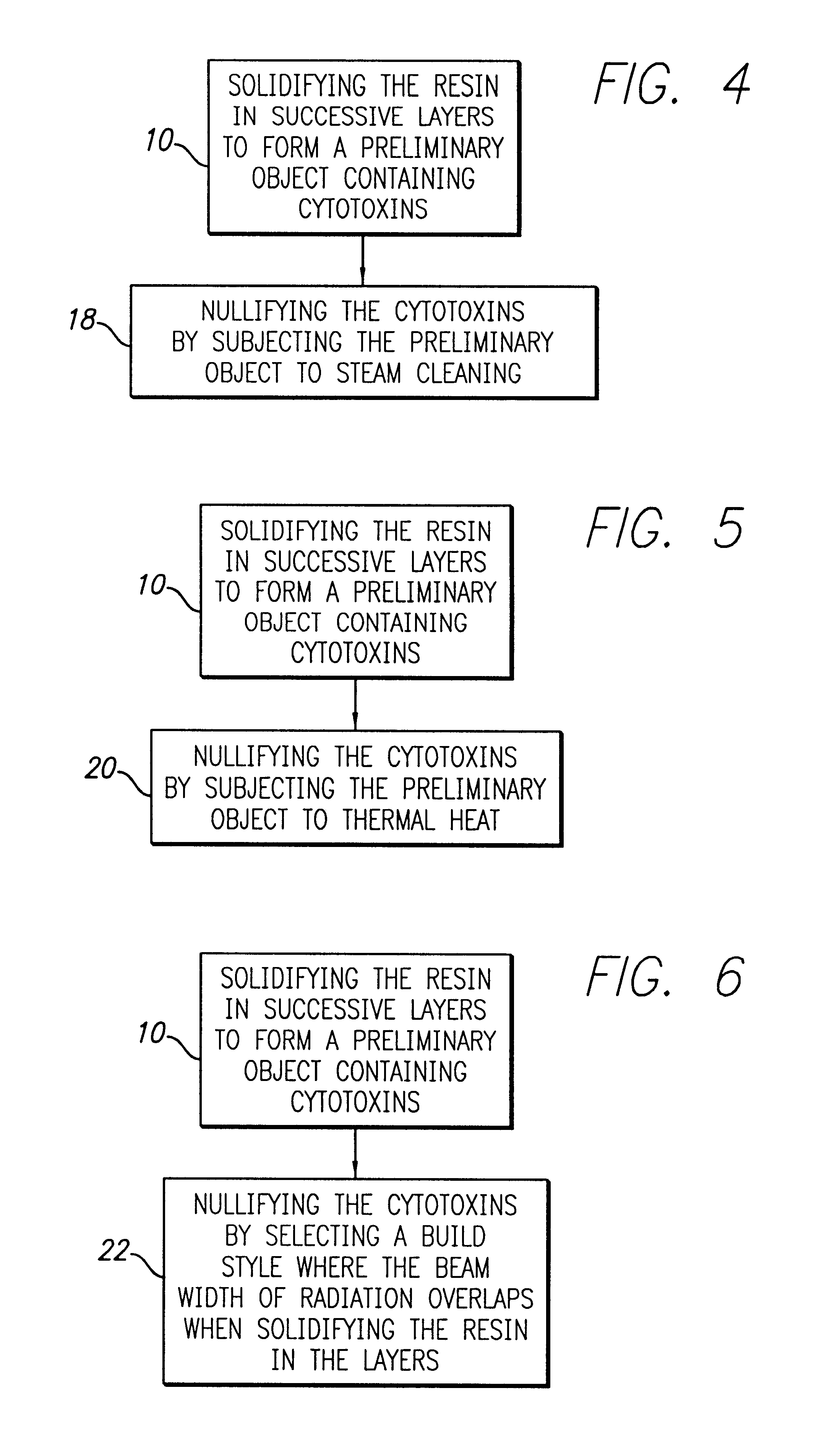Detoxification of solid freeform fabrication materials
a technology of freeform fabrication and detoxification, which is applied in the direction of prosthesis, electric/magnetic/electromagnetic heating, mechanical vibration separation, etc., can solve the problems of limited development of biocompatible materials for use in solid freeform fabrication techniques, inability to identify specific cytotoxins in a specific material, and inability to meet the requirements of a specific material
- Summary
- Abstract
- Description
- Claims
- Application Information
AI Technical Summary
Benefits of technology
Problems solved by technology
Method used
Image
Examples
example 1
Ultrasonics
A method for producing non-cytotoxic parts from a photocured acrylate or epoxy / acrylate test article by employing an ultrasonic bath filled with isopropyl alcohol was developed. It was discovered that the preliminary objects could essentially be rendered non-cytotoxic by ultrasonic cleaning in a bath of solvent such as isopropyl alcohol. Preliminary objects were built on a 3D Systems' SLA.RTM. 3500 system as described previously. The samples were then placed in a VWR Aquasonic75T ultrasonic cleaner available commercially from VWR Scientific Products of West Chester, Pa., and filled with isopropyl alcohol. The samples were subjected to ultrasonic stimulation for about 0.5 hours within the isopropyl alcohol. The samples were then transferred to a smaller ultrasonic unit, namely, a L & R Model PC3 ultrasonic cleaner available commercially from Edmond Scientific of Tonawanda, N.Y. The samples were then further subjected to ultrasonic stimulation in isopropyl alcohol for an ad...
example 2
Chemical Extraction
A chemical extraction process was also developed to detoxify some of the preliminary test samples produced as discussed above. The preliminary test samples were placed in a 33 .times.80 mm cellulose thimble within a 45 / 50 Kimax soxhlet extractor / allihn condenser apparatus commercially available from Fisher Scientific International, Inc., of Hampton, N.H. The extractor was attached to a 500 mL round bottom flask filled with isopropyl alcohol as the extraction medium. The isopropyl alcohol was brought to a boil by heating the alcohol over a heated oil bath. The water-jacketed allihn condenser located above the soxhlet extractor condensed the isopropyl alcohol. The condensed alcohol was collected in the receiving area of the extractor around the test samples and eventually drained from the receiving area through the siphon on the side of the soxhlet extractor. As the isopropyl alcohol was drained from the extractor, freshly distilled isopropyl alcohol was continuousl...
example 3
Autoclaving
Preliminary objects were produced as described previously with STEREOCOL.TM. Y-C 9300R resin. These samples were then UV postcured for 90 minutes in a PCA.TM. 3500 apparatus as described previously. They were then shipped to an independent testing laboratory and subjected to vapor treatment in an Amsco Model 3000SL autoclave. This autoclave and others are available, for instance, from Lancer Medical Services, Inc., of Azusa, Calif. The autoclave was operated in gravity mode between about 121.degree. and about 124.degree. C. for about thirty minutes at a pressure of about 18 psig. The autoclave treated test samples were then tested for cytotoxicity and found to yield a score of 0, thus the test samples were rendered nontoxic. This detoxification process took the shortest time to complete and also produced the lowest cytotoxicity results. The operation temperature of the autoclave could be increased or decreased if desired. In addition, the time duration of the autoclave co...
PUM
| Property | Measurement | Unit |
|---|---|---|
| temperature | aaaaa | aaaaa |
| temperature | aaaaa | aaaaa |
| temperature | aaaaa | aaaaa |
Abstract
Description
Claims
Application Information
 Login to View More
Login to View More - R&D
- Intellectual Property
- Life Sciences
- Materials
- Tech Scout
- Unparalleled Data Quality
- Higher Quality Content
- 60% Fewer Hallucinations
Browse by: Latest US Patents, China's latest patents, Technical Efficacy Thesaurus, Application Domain, Technology Topic, Popular Technical Reports.
© 2025 PatSnap. All rights reserved.Legal|Privacy policy|Modern Slavery Act Transparency Statement|Sitemap|About US| Contact US: help@patsnap.com



